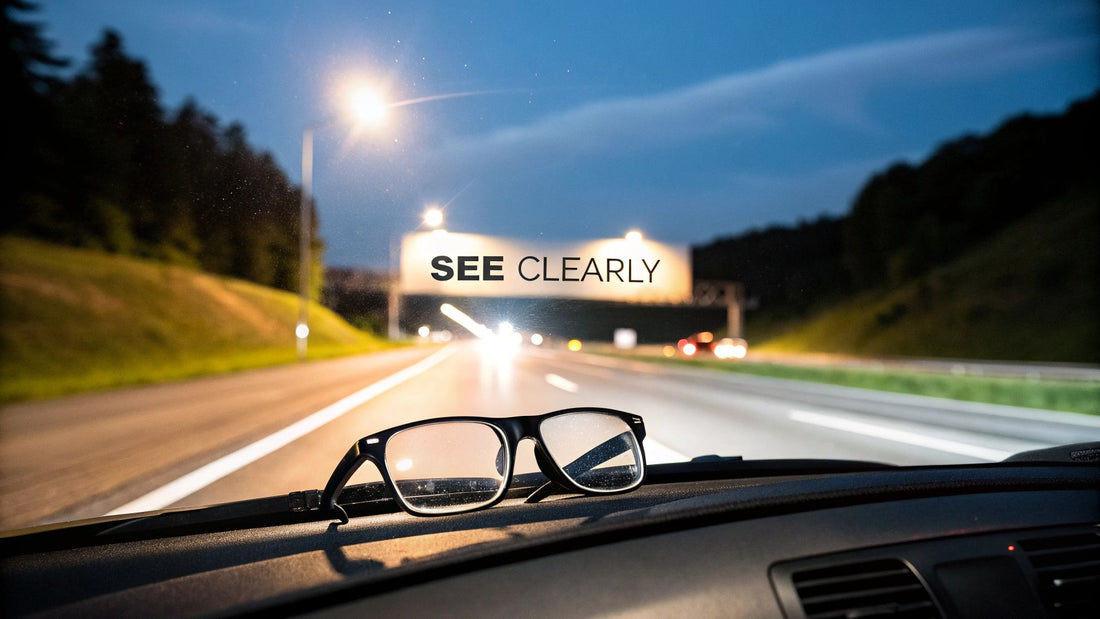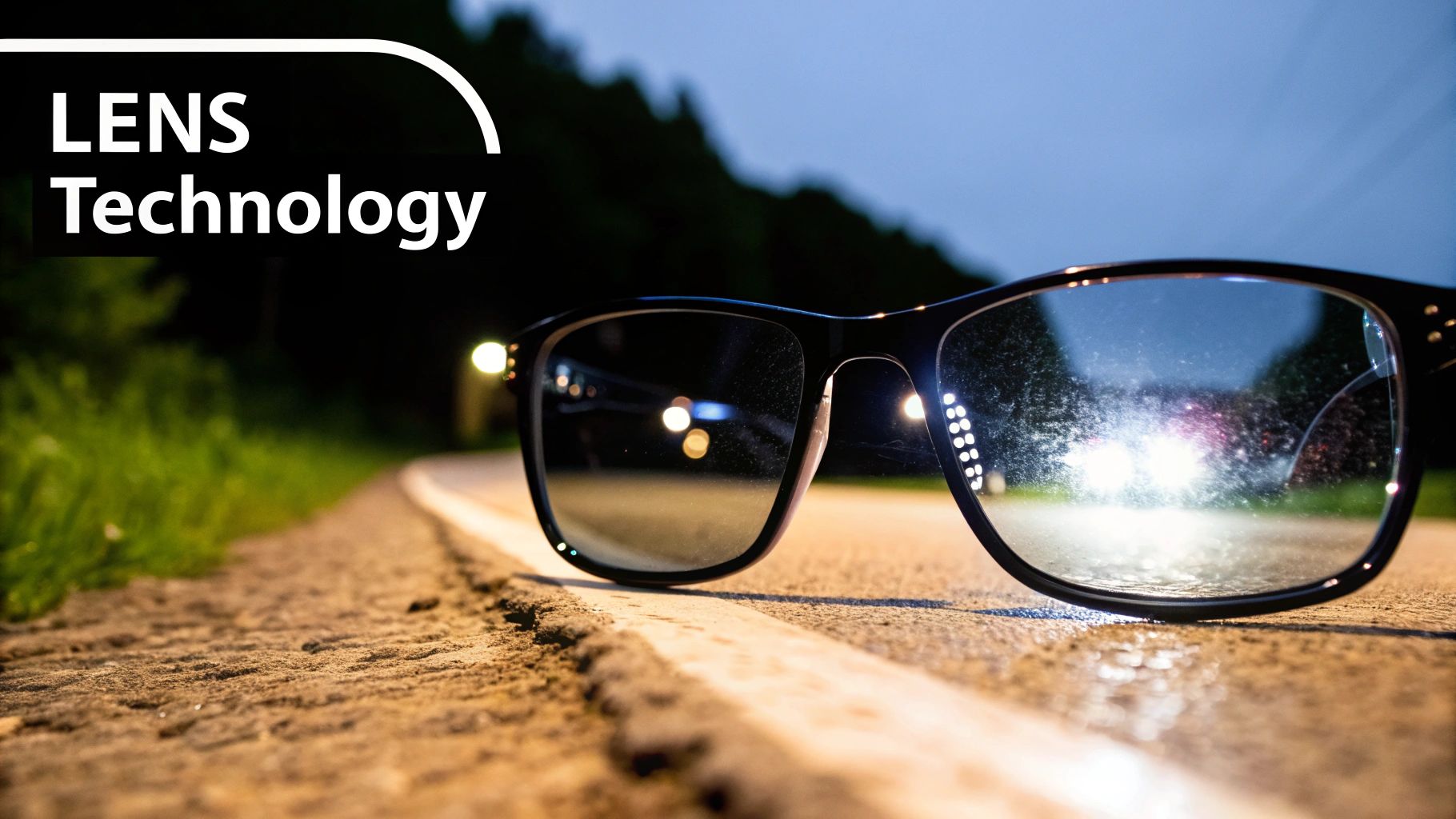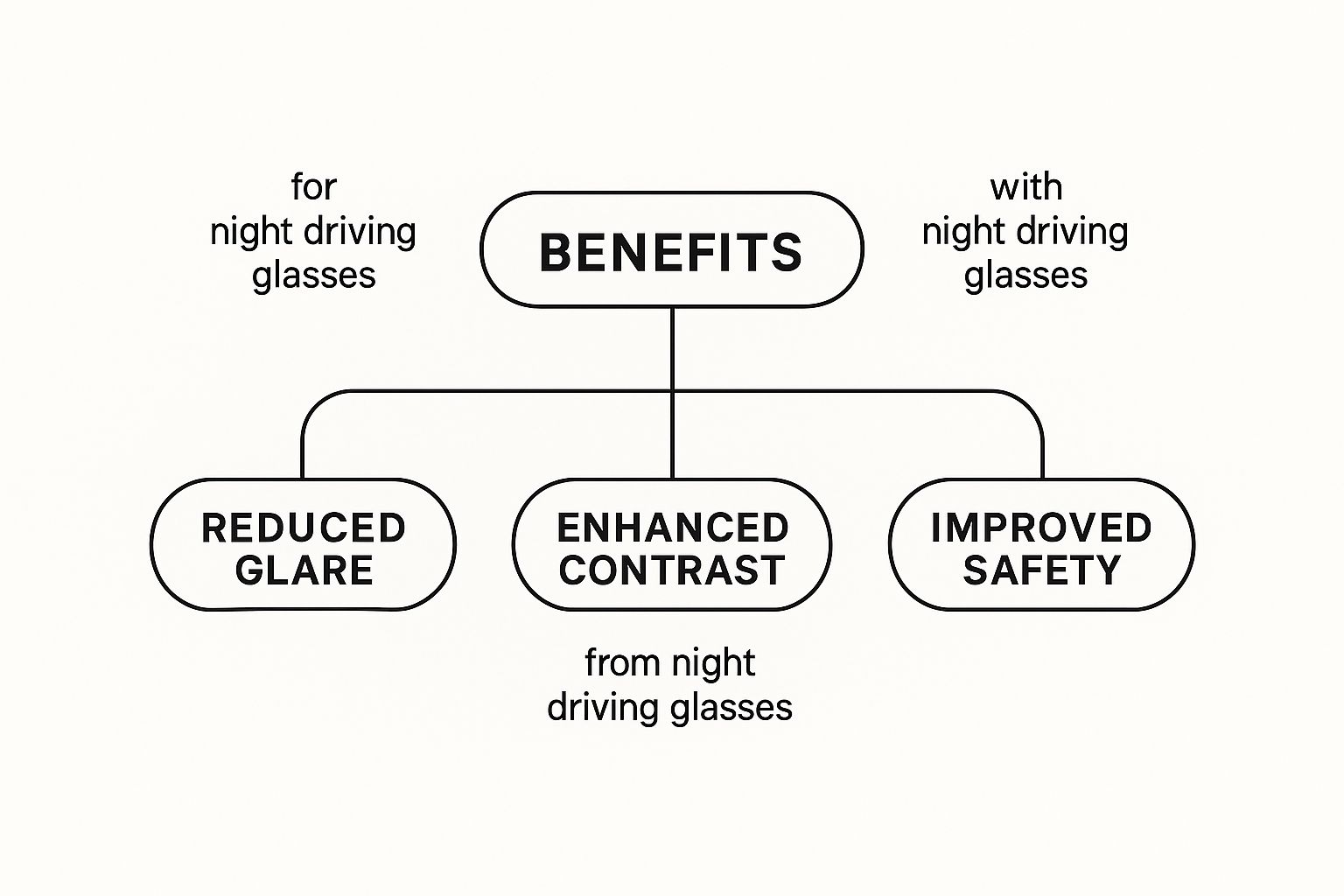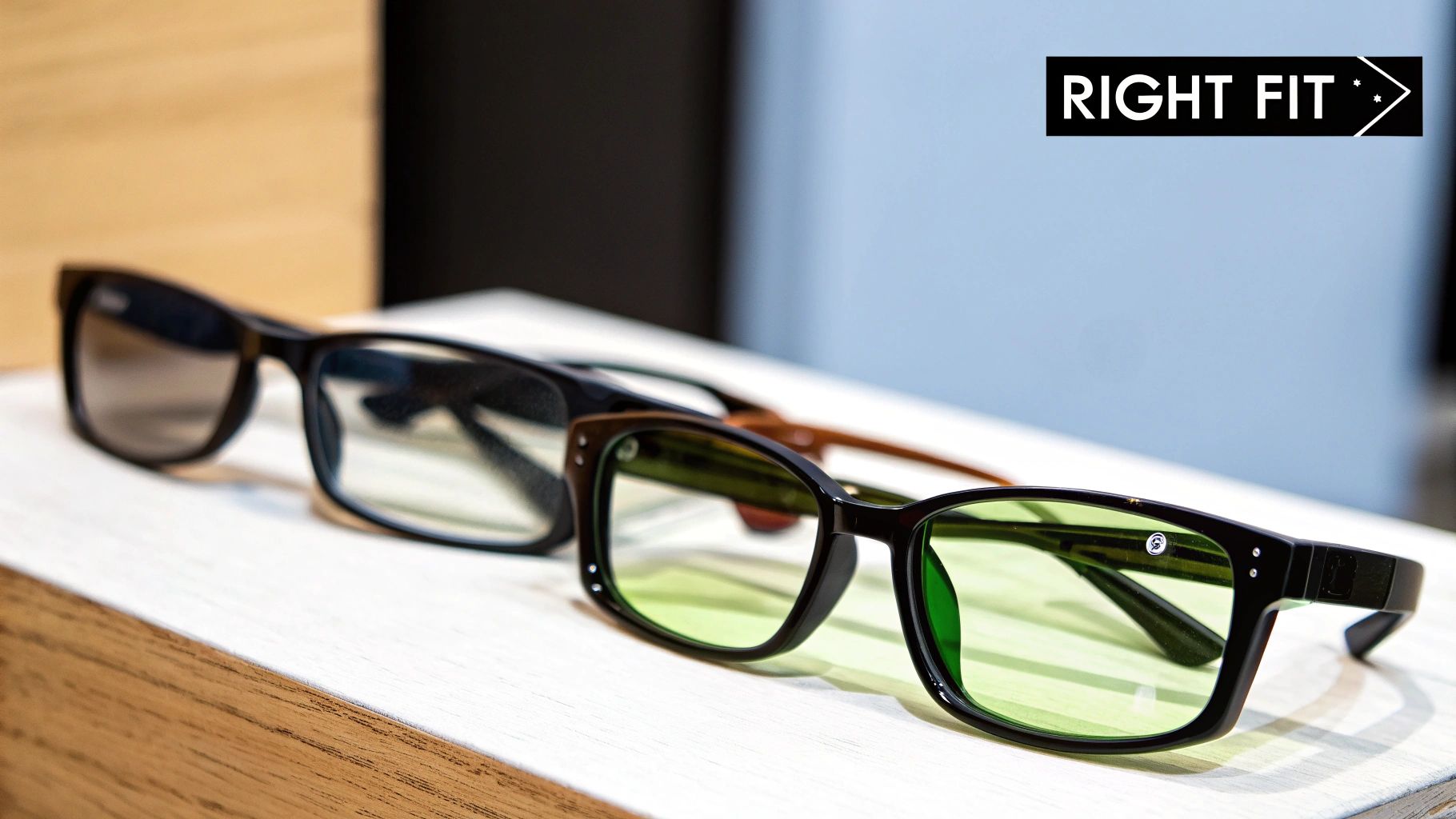
Night Driving Glasses Guide: See Clearly After Dark
Why Night Driving Glasses Are Your Road Safety Game-Changer
Driving at night can be a genuinely stressful experience, and that feeling isn't just in your head. Imagine this all-too-common scenario: you're heading home after a long day, and suddenly, a blast of oncoming headlights turns your view into a blinding starburst. Your eyes water, you squint, and a simple drive instantly becomes an anxious ordeal. This is the exact moment where night driving glasses can become your eyes' most reliable partner on the road.

Think of them as advanced filters, working much like noise-canceling headphones do for your ears. Instead of just making everything darker, they selectively manage the scattered, chaotic light that causes dangerous glare. This process filters out the visual "noise" while letting you keep the clear information you need to drive safely. It’s this selective filtering that makes them a true game-changer for nighttime safety.
Common Struggles, Real Solutions
The true value of quality night driving glasses shines through in real-world situations every driver knows well. These specialized lenses make a noticeable difference when you're:
- Driving in the rain: Wet pavement acts like a mirror, reflecting light from every direction and making it hard to see lane markings or other cars. The right glasses cut through that visual mess.
- Navigating busy intersections: With multiple traffic signals, storefront signs, and crossing headlights, intersections can create a visually confusing mess. Night glasses help organize this light so you can focus on what's important.
- Facing modern LED headlights: The bright, blue-heavy light from newer headlights is a major cause of glare. Specially tinted lenses can soften this intensity without hurting your overall visibility.
The growing focus on road safety isn't just a feeling; it's a significant market force. In 2022, the market for these glasses was valued at around USD 2.35 billion, and it's expected to grow to approximately USD 5.18 billion by 2030. This increase shows just how seriously drivers are starting to take the risks of driving after dark.
To put this in perspective, it's helpful to consider all parts of road safety. For instance, knowing how to Make Your Drive Safe through proper vehicle preparation and insurance is a great complement to the visual protection that good eyewear provides. By tackling these common challenges, night driving glasses help turn your trips after dark from a stressful test of endurance into a comfortable and routine drive.
The Technology That Makes Night Vision Enhancement Actually Work
Let's pull back the curtain on the science behind night driving glasses without needing a degree in optics. Think of your eyes as high-performance cameras trying to get a crisp shot in low light. Just like a professional photographer uses special filters to improve their photos, these glasses use specific lens technologies to fine-tune what you see. The goal isn't to magically create more light, but to make the available light clearer by managing it better.

This improvement comes from a few key features working in harmony to reduce visual noise. By understanding how they work, you can see how they add up to a safer, less stressful drive after dark.
The Power of Polarization and Coatings
The first important technology is polarization, which acts like a smart filter for light. Light from headlights, street lamps, and reflections off wet pavement scatters in all directions. The most intense, blinding glare comes from horizontal light waves. Polarized lenses are built to specifically block these disruptive horizontal waves while letting useful vertical light through. This is what slashes those blinding flashes that make you squint, allowing you to focus on important details like road signs and lane markings.
On top of this, quality night driving glasses include an anti-reflective (AR) coating. Picture this coating as an invisible layer that prevents light from bouncing off the front and back of your lenses. Without it, you’d see distracting internal reflections that create visual "static" or ghost images, which is especially noticeable at night when your eyes are already strained. By using advanced filters and coatings, these glasses significantly cut down on glare from oncoming traffic, which helps reduce eye fatigue and can improve your reaction time. You can find a more detailed look at these technologies and their market growth in this market analysis of night vision driving glasses.
Why the Yellow Tint Is a Key Player
That distinct yellow tint on many night driving glasses isn’t just for looks—it plays a crucial role. This tint works by filtering out a specific part of the light spectrum: high-energy visible (HEV) blue light. Blue light has a tendency to scatter more easily than other colors, which creates the fuzzy "halo" effect you see around headlights and streetlights.
By screening out much of this distracting blue light, the yellow lenses make the remaining light seem sharper and more defined. This boosts the contrast between different objects, making it easier to spot a pedestrian on the shoulder or a pothole in the road ahead. It's this one-two punch of glare reduction and contrast improvement that truly helps to improve night vision with night driving glasses, turning a blurry, stressful drive into a clearer, more controlled experience.
Essential Features That Separate Effective Glasses From Gimmicks
Not all night driving glasses are created equal. Choosing a pair is a bit like picking a camera: a basic smartphone and a professional DSLR both take pictures, but their quality, features, and the final results are worlds apart. To find glasses that genuinely improve your safety, you need to look past flashy marketing and focus on the features that truly deliver clarity on the road.
This simple concept map shows how the right features work together to create a safer driving experience.

As you can see, the path is clear: specific features lead directly to reduced glare and better contrast, which are the building blocks of improved nighttime driving safety.
Lens Quality and Tint: The Heart of Performance
The most critical part of any pair of night driving glasses is the quality of its lenses. Subpar lenses can introduce optical distortions, warping your view and making your vision worse, not better. Always look for lenses made from high-grade materials that promise a clear, distortion-free view of the road.
The lens tint is just as important. A light yellow or amber tint has become the standard for a good reason. It’s designed to filter the harsh, high-energy blue light that comes from modern LED headlights and streetlights—a primary source of blinding glare and eye fatigue. This filtering effect sharpens your surroundings and improves contrast, making it easier to spot pedestrians, signs, and other cars in low light.
However, be wary of tints that are too dark. Lenses that block too much light can dangerously reduce visibility, working against their intended purpose. Effective glasses should never act like sunglasses. You can learn more about the crucial balance by exploring the benefits and dangers of night driving glasses to make a well-informed decision.
Frame Design and Coatings: Comfort Meets Durability
For any drive, especially a long one, a comfortable frame is absolutely essential. Look for these key elements:
- Lightweight Materials: Heavy frames create uncomfortable pressure points on your nose and behind your ears, leading to distraction and fatigue.
- Secure Fit: The glasses should sit securely on your face without feeling too tight. Wraparound designs are great for providing better peripheral vision and stability.
- Durable Construction: Check for sturdy hinges and strong frame materials that can handle the bumps and drops of regular use.
To help you sort through these options, here’s a quick comparison of the most important features.
Night Driving Glasses Feature Comparison
Comparison of key features and their benefits for different driving conditions
| Feature | Benefit | Best For | Considerations |
|---|---|---|---|
| Yellow/Amber Tint | Filters harsh blue light, reduces glare, and enhances contrast. | All-purpose night driving, especially in urban areas with many LED lights. | Tints that are too dark can impair vision. Look for light tints only. |
| Polarization | Dramatically reduces glare from reflective surfaces like wet roads or oncoming traffic. | Driving in rainy or wet conditions, and areas with heavy oncoming traffic. | Can sometimes make it hard to read LCD screens, like those on your dashboard. |
| Anti-Reflective (AR) Coating | Prevents internal reflections and "ghost images" on the lenses. | Essential for all night driving to ensure the clearest possible view. | The quality of the coating matters. A cheap AR coating can peel or scratch easily. |
| Wraparound Frame | Provides better peripheral vision and blocks light from entering from the sides. | Highway driving and anyone wanting maximum light-blocking coverage. | May not fit as comfortably over prescription glasses. |
| Lightweight Frame | Increases comfort for long durations, preventing pressure points and headaches. | Long-distance drivers, commuters, and professional drivers. | Ensure the material is also durable (e.g., TR90 or high-grade polycarbonate). |
This table shows that the best glasses combine several key features—like a light tint, a quality AR coating, and a comfortable frame—to create a tool that truly supports safer driving.
Finally, any effective pair of night driving glasses must have a high-quality anti-reflective (AR) coating. This coating is applied to both sides of the lens to stop distracting reflections, also known as "ghost images," from appearing in your line of sight. A good AR coating is fundamental for clear vision. A scratch-resistant coating is another practical feature that protects your investment, keeping your lenses clear and effective for many miles to come. When these features come together, they give you a reliable tool for confident night driving.
Finding Your Perfect Match: Types For Every Driver's Needs
Just as you wouldn't use a compact car for a heavy-duty hauling job, the right night driving glasses depend on your specific needs. Finding the perfect pair isn't about a single "best" option but about matching the glasses to your driving habits, typical environment, and whether you already wear prescription lenses. Let's break down the main types to see which one is the right co-pilot for you.
The Classics: Tinted and Polarized Lenses
For years, yellow-tinted glasses have been the classic choice for many drivers. Imagine them as a filter that specifically targets and reduces harsh blue light. By doing this, they can make the world seem sharper and more defined, especially in urban areas filled with streetlights. This filtering helps cut down on that fuzzy "halo" effect you see around light sources at night.
Polarized night driving glasses, on the other hand, are like high-performance sunglasses designed for the dark. Their main mission is to combat intense, direct glare. Think about the blinding reflection of headlights on a rain-slicked road—that's where polarization shines. In fact, due to their superior ability to tackle this kind of glare, polarized lenses dominate the market, making driving much more comfortable and safer. You can find more information about these market trends for night vision driving glasses.
Solutions for Prescription Eyewear Users
If you already rely on glasses to see clearly, you don't have to sacrifice sharp vision for glare reduction. Several clever solutions are available to give you the best of both worlds.
- Clip-On Glasses: These are the simplest and most cost-effective route. They attach right onto your existing frames, instantly giving your prescription glasses night driving capabilities. They're also lightweight and easy to tuck away in your glove compartment.
- Wraparound (Fit-Over) Styles: Think of these as a protective shell for your regular glasses. They are designed to fit comfortably over your existing eyewear, providing comprehensive coverage. This is a huge plus because they block stray light from sneaking in through the sides—a common issue on dark highways or rural routes.
- Dedicated Prescription Lenses: For the ultimate, most integrated experience, you can invest in a dedicated pair of prescription night driving glasses. This option merges your vision correction with the glare-reducing lens technology into a single, seamless pair of glasses, eliminating the extra bulk of other solutions.
Your Step-By-Step Selection Strategy That Actually Works
Choosing the right night driving glasses isn't a matter of luck; it's about following a clear plan. Think of it like buying a quality kitchen knife—you wouldn’t just grab the first one you see. You'd consider its weight, balance, and what you’ll be cutting. This same deliberate approach ensures you get a tool that genuinely improves your driving safety and comfort, saving you from buyer's remorse later on.
This process is designed to cut through the noise and guide you to a pair that fits your specific visual needs and driving habits.
Assess Your Primary Challenges
Before you even think about brands or prices, take a moment for an honest self-assessment. What are the specific problems you face when driving after dark? Identifying your main pain points is the most important step in finding a worthwhile solution.
- Glare Source: Is your biggest issue the blinding, direct glare from oncoming LED headlights? Or is it the disorienting, reflective glare that bounces off wet roads, making lane lines disappear?
- Vision Correction: Do you already wear prescription glasses? This will guide your decision between clip-on styles, larger fit-over frames, or a new pair of dedicated prescription night glasses.
- Driving Environment: Where do you do most of your night driving? Is it on well-lit city streets, or do you frequently find yourself on unlit rural highways where maximizing contrast is essential?
Set a Budget and Prioritize Features
With a clear picture of your needs, you can establish a practical budget. Eyewear is an investment in your safety, so it's wise to prioritize quality. Decide which features are your "must-haves" and which are "nice-to-haves."
For example, high-performance polarization and a quality anti-reflective coating should probably be non-negotiable. A specific frame material or designer brand, on the other hand, might be lower on your list. This helps you balance cost with the features that will actually make a difference on the road.
To help you match your needs with the right features, we've created a guide. This table breaks down what to look for based on common driving scenarios.
| Driving Condition | Recommended Features | Price Range | Top Considerations |
|---|---|---|---|
| Urban/City Driving | Moderate yellow tint, anti-reflective coating | $30 - $70 | Focus on reducing streetlight halos and oncoming headlight glare. Polarization may not be essential. |
| Rural/Highway Driving | High-contrast yellow or amber lenses, strong polarization | $50 - $150+ | Prioritize lenses that enhance contrast to see road markings and potential hazards in low light. |
| Rainy/Wet Conditions | Polarized lenses are essential, hydrophobic coating | $60 - $200 | Polarization cuts through the intense glare from wet surfaces. A water-repellent coating keeps vision clear. |
| For Prescription Wearers | Fit-over styles, custom prescription, or clip-ons | $40 - $300+ | Comfort is key. Ensure fit-overs are not too heavy and clip-ons are secure and don't scratch your primary lenses. |
This table shows that the best choice depends entirely on your personal context. A driver on dark country roads has very different needs than someone navigating a brightly lit downtown.
Evaluate and Make a Decision
Now that you have your criteria and budget, it's time to compare products. Go beyond the marketing slogans. Read customer reviews carefully, paying close attention to feedback that describes specific situations, like driving in heavy rain or dealing with large truck headlights. Learn to recognize red flags like vague praise or multiple complaints about flimsy frames or easily scratched lenses, which often indicate lower quality.
It's also a good idea to speak with an eye care professional. This is especially true if you have existing vision issues or take medications that might affect your night vision. Their expert opinion can confirm whether night driving glasses are a suitable option for you. For those who also enjoy off-road adventures, a detailed goggle buying guide can provide further knowledge on selecting eyewear for varied and demanding conditions. Following this structured approach will help you find a pair that truly delivers on its promise.
Getting Maximum Value From Your Investment
Owning a pair of night driving glasses is the first step, but truly getting the most out of them means doing more than just sliding them on. Think of them like a high-performance tool; their effectiveness hinges on using them correctly and taking care of them. You wouldn't neglect a finely-tuned instrument, and your glasses need the same attention to deliver their best, drive after drive.
Adjusting to Your New View
When you first put on your new glasses, the world might look a little different. This is a completely normal part of the adaptation period. For some people, the sharper contrast and subtle color shift feel great immediately. For others, it might take a few drives to get fully comfortable.
To help your eyes and brain get acquainted, try these simple steps:
- Start with short drives: Wear them on familiar, low-key routes first. This lets you get used to the visual changes without the pressure of a challenging drive.
- Focus on the benefits: Actively notice how the blinding glare from headlights feels less intense and how road markings pop with new clarity. This helps your brain link the new view with a safer, more relaxed driving experience.
- Avoid difficult conditions at first: Don't make your inaugural drive a long trip in a heavy rainstorm. Give yourself time to ease into it.
Care and Maintenance for Lasting Clarity
The specialized anti-glare and anti-reflective coatings on your lenses are the secret to their performance, but they are also quite delicate. Cleaning them the wrong way can cause permanent damage, reducing their effectiveness and your investment.
To clean your glasses the right way:
- Start by rinsing them under lukewarm water. This washes away any tiny dust or grit particles that could scratch the lenses.
- Put a single drop of lotion-free dish soap on your fingertips and gently rub both sides of each lens.
- Rinse them completely, then dry them with a clean, soft microfiber cloth. Never use paper towels, tissues, or the hem of your shirt. These materials feel soft, but they have abrasive fibers that will create tiny scratches on the lens coatings.
This simple maintenance routine ensures your glasses continue to provide sharp, clear vision for many miles to come. The rising interest in night driving glasses is part of a larger trend toward prioritizing eye safety, with new lens technologies pushing the market forward. You can see a detailed analysis of the night driving glasses market growth to understand how these features are attracting more drivers. By following these care tips, you'll ensure your glasses, like those in our Lumin Night Driving Glasses collection, remain a trusted tool for safety and comfort.
Your Roadmap To Safer, More Confident Night Driving
Think of this final step not as just buying another accessory, but as an investment in your own safety and peace of mind on the road after dark. This is your personal action plan, designed to help you turn what you've learned into a smart, practical decision that makes every nighttime journey feel more secure.

From Information to Confident Action
The best night driving glasses for you are the ones that actually solve your specific visual challenges. Let's boil everything down into a simple checklist to help you choose wisely.
- Set Realistic Expectations: It's important to remember what these glasses do. They are designed to cut down on harsh glare and make contrasts sharper, not to magically transform night into day. Think of them as a tool for managing difficult light, not a cure-all for every night vision problem.
- Prioritize Quality Over Price: A cheap pair might seem like a bargain, but effective glare reduction depends on quality polarization and anti-reflective (AR) coatings. When you spend a bit more on well-made lenses, you're really paying for a higher degree of safety.
- Match Features to Your Environment: Think about where you drive most. If you're often in rainy, reflective city conditions, focus on polarization. If your biggest headache is the intense glare from modern LED headlights on unlit country roads, a quality, lightly-tinted lens with a good AR coating will be your best friend.
Market data reveals that these glasses are popular across many age groups, with a strong interest from older drivers who are dealing with age-related changes in their night vision. For more on these consumer trends, you can review the night vision driving glasses market research. For some, driving at night is a major source of stress, which makes tools like these incredibly helpful. If general driving stress is an issue, specialized driving lessons for nervous drivers can also offer great support to help build your confidence behind the wheel.
Knowing When They're Working (And When to Upgrade)
So you've got your glasses—how can you tell if they're doing their job? The signs should be clear. You ought to notice a real decrease in the "starburst" or "halo" effect from oncoming lights. Road signs and lane markings should appear more distinct and easier to read. Most importantly, you should feel your eye muscles relax instead of being tensed up from constant squinting.
On the flip side, there are signs that you might need a new pair. If you experience headaches, see scratches on the lenses that distort light, or feel like the glare is no longer being managed effectively, it's time for an upgrade. Lens technology is always improving, and a pair that was great five years ago might be outmatched by newer, more effective options available today.
Ready to take control of your night driving experience? Explore the science-backed, stylish options in the Spektrum Glasses collection and find the perfect pair to bring clarity and confidence to your drive.
Article created using Outrank
